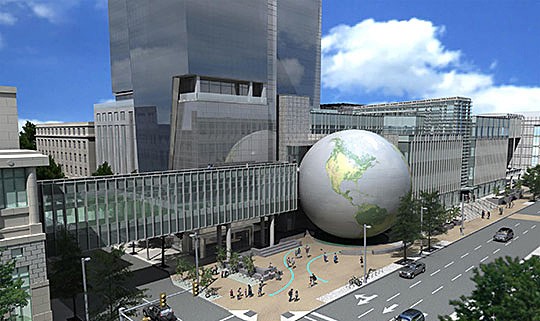Tom Theobald from Fentress Architects has been involved in the recently opened Green Square Complex in North Carolina, the US.
Theobold has served as a project manager/project architect and construction administrator on many major projects and has been involved with the modernisation of the international terminal at LAX (scheduled to open in May, 2013) and the Raleigh Durham International Airport (completed 2010).
The newly-opened Green Square Complex project creates an experiential environment where the public can learn about environmental issues affecting everyday life through interacting with actual scientists and their ongoing research projects.
Architecture & Design spoke to him about working on the Green Square Complex, the sustainability initiatives at the project and why a team effort is so important on projects.
 The Green Square Complex project designed by Fentress Architects in association with O’Brien/Atkins Associates
The Green Square Complex project designed by Fentress Architects in association with O’Brien/Atkins Associates
How have you created an interactive building where the public can learn about environmental issues?
We created Green Square to be interactive and educational on many levels. It starts even as you approach it with the permeable sidewalks. The interior is filled with daylight and the materials chosen for every surface invite touch. Even the exhibits themselves are hands-on, helping the visitor understand the North Carolina environment and the impact external forces have on it. Then there’s the green roof, one of the signature elements of the building. It’s an example of how the built environment is experienced by the visitors to the building, which is a living laboratory for sustainability issues.
How hard was this to do?
Any time you have such an intensively collaborative process between so many parties, there are going to be challenges. But this team was highly professional. Everyone worked closely together because we shared a vision for what we wanted it to be.
What were some of the challenges of the project?
Deciding in a group environment what elements could be incorporated into the environment, and to what level. Being an extension of the Department of Environment and Natural Resources, we needed to show not only that the building was sustainable, but sustainable in a practical, useful way. The goal was to show technologies that could be incorporated into other projects and used as a guide for other future projects.
How did you overcome those challenges?
Communication is one of the most important aspects of any project and through our collaboration workshops, meetings and discussions, all parties got to voice their opinions and preferences.
What was the most rewarding part of the project?
Seeing the joy on the visitors faces as they started to use and explore the Nature Resources Center, the look of awe when they walk into a building that is so active and vibrant. You can tell the people who visit it are very excited about the spaces that are created.
Can you tell A&D about some of the sustainability aspects of the project?
The green roof is one of the main environmental features. By selecting plants that were able to filter water as we needed, we made the roof work as designed. Water runoff runs down a channel on the side of the building where it’s collected in a cistern and reused. When it’s raining, you can see water cascading down in a waterfall into the cistern. We designed this feature to be very visual, so people would be able to engage with it and better understand the processes we were using.
The permeable sidewalk is another such feature. The pavers we chose allow water to go through them and pass directly into the earth. Traditional impermeable sidewalks take the water and put it right into the sanitary system where it needs to be collected and treated before reuse. We also used as much upcycled and recycled material as possible throughout the design.
What has been the most rewarding project you have worked on?
As much as I love Green Square, I’d have to say it’s another North Carolina project: the Raleigh-Durham International Airport. We wanted to create an iconic building, of course, but to do that you need the commitment and vision of the whole team. And that’s exactly what the RDU team had. It was very inclusive and allowed for everyone to feel they were part of the process. To me, the most rewarding part was the relationships that were built in the process.
What has been the most important lesson you’ve learnt in your career?
Nothing gets accomplished without the effort of many people – firms, committees, groups. The most successful projects find ways to have a collective goal so that everyone has the same end-product in mind, whether it’s an iconic building or a cost-effective building. If you can build consensus and everyone is working toward that single goal, then you’ll have a successful project.

